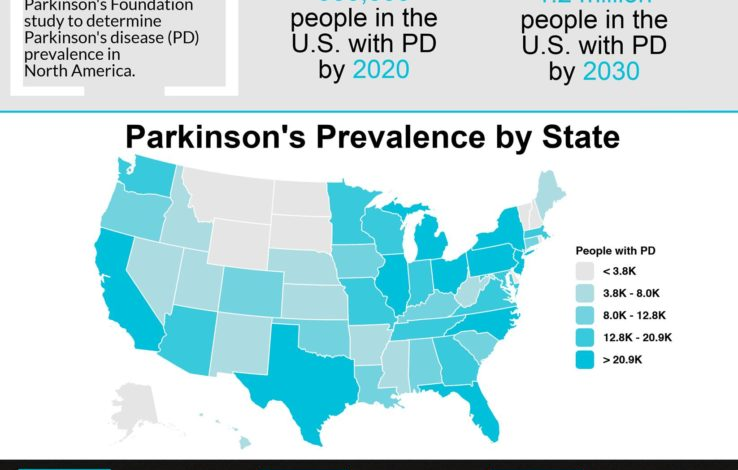Parkinson’s Disease Prevalence: Expected to Double by 2050

Parkinson’s disease prevalence is projected to undergo a staggering increase in the coming decades, with estimates suggesting that global Parkinson’s cases could double by 2050, affecting up to 25 million individuals worldwide. This significant rise, as highlighted by recent Parkinson’s disease statistics, underscores the urgent need for increased awareness and intervention strategies. Research indicates that the prevalence of this neurodegenerative disease will rise from 267 cases per 100,000 people in 2021, marking a 76% increase as the population ages. Notably, the elderly population, particularly those aged 80 and above, is expected to experience the most dramatic rise in cases, with an anticipated 196% increase by 2050. As the future of Parkinson’s disease looms, the implications for healthcare systems are profound, prompting ongoing research to address this evolving health crisis.
The growing concern surrounding the frequency of this neurological movement disorder has sparked discussions around its implications for global health. As we look ahead, the looming challenge of neurodegenerative disorders, such as Parkinson’s disease, is set to reshape healthcare landscapes worldwide. By examining current data and projections, experts are attempting to unravel the complexities linked with Parkinsonism, leading to increased awareness about its incidence in aging populations. Not only does this spotlight the number of affected individuals, but it also emphasizes the importance of preventative measures and early interventions. As we approach 2050, understanding the dynamics of these conditions remains critical for developing effective strategies to combat their rise.
The Growing Prevalence of Parkinson’s Disease
Recent studies indicate a striking increase in the prevalence of Parkinson’s disease, suggesting that by 2050, approximately 25 million people worldwide will be living with this neurological disease. Parkinson’s disease, which presently affects around 15 million globally, is projected to reach a prevalence rate of 267 cases per 100,000 individuals. This significant uptick, amounting to a 76% increase from current statistics, illustrates a concerning trend in neurodegenerative diseases that health experts cannot overlook.
The demographic shift in the aging population plays a crucial role in this alarming statistic, particularly among individuals aged 80 and older. Researchers have highlighted that the anticipated rise in cases among this age group is expected to be as high as 196% by 2050. Such findings underscore the urgent need for intensified research and investment into both preventive measures and effective therapies to manage this growing health issue.
Impact of Aging on Parkinson’s Disease Statistics
The implications of an aging population on Parkinson’s disease statistics are profound and multifaceted. By 2050, demographic changes, particularly the increase in the elderly populace, will account for a staggering 89% of the total rise in Parkinson’s cases. This effect is compounded by global population growth and shifts in disease prevalence, emphasizing the need for adaptive health strategies that cater specifically to older adults.
With aging being a significant risk factor for Parkinson’s disease, it is vital to understand how this demographic will influence healthcare systems worldwide. Anticipating a greater number of cases will necessitate increased healthcare resources and targeted interventions to improve patient outcomes. Continued research into the effects of aging on neurodegenerative diseases is essential for designing effective public health policies.
Future Projections for Parkinson’s Disease Cases
Forecasts regarding the future of Parkinson’s disease paint a stark picture. Experts suggest that not only will the number of global Parkinson’s cases double by 2050, but the fate of those diagnosed will depend heavily on advancements in medical research and treatment options. The trends indicate that as the global population ages, Parkinson’s will become increasingly prevalent, necessitating an urgent response from the medical community to address prevention and treatment strategies.
In light of these projections, it is crucial for policymakers, researchers, and public health officials to work collaboratively. Effective targeting of prevention interventions based on these future prevalence rates will be vital. Emphasizing the need for education and awareness about Parkinson’s disease becomes even more critical as we approach these daunting statistics.
Regional Disparities in Parkinson’s Disease Prevalence
The projected distribution of Parkinson’s disease cases across different regions of the world highlights significant disparities. East Asia is anticipated to bear the brunt of this epidemic, with an estimated 10.9 million cases by 2050, followed by South Asia with 6.8 million cases. Such regional differences in Parkinson’s disease prevalence underscore the varied impact of demographic factors on health outcomes across the globe.
Understanding these disparities is paramount for resource allocation and healthcare planning. Regions with higher projected rates will require tailored health services to support the influx of Parkinson’s patients. Comprehensive strategies must be developed to address the unique challenges faced by different populations, particularly in areas where healthcare resources may be limited.
Male and Female Prevalence in Parkinson’s Disease
The research findings indicate that men are disproportionately affected by Parkinson’s disease compared to women, with the male-to-female ratio of age-standardized prevalence increasing from 1.46 in 2021 to 1.64 in 2050. This gender disparity raises questions about the biological, environmental, and lifestyle factors that might contribute to the differences in prevalence rates.
To better understand these dynamics, further investigation into how gender influences the onset and progression of Parkinson’s disease is necessary. It is essential for ongoing research to explore the underlying mechanisms behind these disparities and to inform targeted prevention strategies that consider gender differences in neurodegenerative diseases.
Understanding Neurodegenerative Diseases
Neurodegenerative diseases like Parkinson’s are becoming increasingly recognized as significant public health issues. With projections indicating that these diseases will surpass cancer as the second leading cause of death by 2040, it’s vital to raise awareness about the symptoms, progression, and treatment options for Parkinson’s. Education efforts must focus on the importance of early diagnosis and management of symptoms to improve quality of life for patients.
As research continues to evolve, expanding our understanding of the mechanisms behind neurodegeneration is key to developing effective therapies and reducing the burden these diseases present. Collaborative efforts across the scientific community are focusing on both treatment advancements and lifestyle interventions that can mitigate the impacts of these illnesses.
The Role of Global Health Organizations
Global health organizations play an invaluable role in addressing the rising challenge of Parkinson’s disease. Their efforts to gather data, conduct research, and disseminate information are crucial for understanding the full scale and impact of this neurodegenerative disorder. Organizations like the World Health Organization are actively working on strategies to improve the quality of life for those affected and to support ongoing research into its causes and treatments.
Through collaborative initiatives, global health entities aim to create awareness and foster international cooperation, which is essential for combating the future prevalence of Parkinson’s disease. As these organizations continue to advocate for research funding and effective healthcare policies, they contribute to shaping the response needed to manage the increasing burden of Parkinson’s and other neurodegenerative diseases.
Challenges in Healthcare for Parkinson’s Patients
As the prevalence of Parkinson’s disease increases, healthcare systems worldwide will face significant challenges. With an expected doubling of cases by 2050, medical facilities must prepare for a rising demand for neurological care. This includes not only the management of symptoms but also comprehensive support systems that integrate physical, psychological, and social health services for patients.
Addressing these challenges requires proactive planning and resource allocation, including training healthcare professionals to specialize in Parkinson’s care. By developing multidisciplinary teams that can cater to the diverse needs of Parkinson’s patients, we can significantly enhance treatment outcomes and overall patient satisfaction.
Preventative Strategies for Parkinson’s Disease
Given the projected increase in Parkinson’s disease cases, implementing preventative strategies is more crucial than ever. Research indicates that lifestyle factors, such as diet, exercise, and exposure to environmental toxins, can influence the onset of neurodegenerative diseases. Public health initiatives aimed at promoting healthy lifestyle choices may mitigate some risks associated with Parkinson’s disease.
Furthermore, community awareness programs can educate individuals about early symptoms and the importance of seeking medical advice promptly. Proactively addressing modifiable risk factors through public health campaigns will play a critical role in reducing the incidence of Parkinson’s disease as global trends continue to evolve.
Frequently Asked Questions
What is the projected global prevalence of Parkinson’s disease by 2050?
According to recent studies, the global prevalence of Parkinson’s disease is expected to double by 2050, reaching approximately 25 million cases worldwide. This translates to around 267 cases per 100,000 people, marking a 76% increase from 2021.
How does age affect the prevalence of Parkinson’s disease?
The prevalence of Parkinson’s disease significantly increases with age. Most notably, among individuals aged 80 and older, cases are projected to rise by 196% by 2050, indicating a concerning trend as the aging population grows.
What factors are contributing to the increase in Parkinson’s disease cases globally?
The anticipated increase in Parkinson’s disease cases can be attributed to several factors, including population aging, population growth, and changes in prevalence rates. These elements are expected to contribute to 89%, 20%, and 3% of the increase, respectively, from 2021 to 2050.
How do Parkinson’s disease statistics vary by region?
Parkinson’s disease prevalence varies by region, with East Asia projected to have the highest number of cases at 10.9 million, followed by South Asia with 6.8 million. In contrast, regions like Oceania and Australasia are expected to report significantly fewer cases.
What is the male-to-female ratio for Parkinson’s disease prevalence?
The male-to-female ratio of age-standardized prevalence of Parkinson’s disease is projected to increase from 1.46 in 2021 to 1.64 by 2050, indicating that men are expected to be more affected by this neurodegenerative disease than women.
Will neurodegenerative diseases surpass cancer as a leading cause of death?
Yes, forecasts indicate that neurodegenerative diseases, including Parkinson’s disease, are predicted to surpass cancer as the second leading cause of death globally by 2040.
Why is it important to understand the future prevalence of Parkinson’s disease?
Understanding the future prevalence of Parkinson’s disease is crucial for effective targeting of prevention and intervention strategies. It helps healthcare systems prepare for the impending rise in cases and allocate resources accordingly.
| Key Point | Details |
|---|---|
| Projected Increase in Cases | Parkinson’s disease cases could double by 2050, affecting 25 million people globally. |
| Prevalence Rate | Expected prevalence of 267 cases per 100,000 people by 2050, a 76% increase from 2021. |
| Aged Population Impact | The most significant rise is among those aged 80+, with an anticipated increase of 196%. |
| Research Source | Findings published in The BMJ; based on Global Burden of Disease data. |
| Future Projections | Population aging and growth will contribute 89% and 20% respectively to the increase in cases by 2050. |
| Gender Disparity | Men are expected to be more affected, with male-to-female ratio rising from 1.46 in 2021 to 1.64 in 2050. |
| Geographic Distribution | Highest cases in East Asia (10.9 million) and South Asia (6.8 million); lowest in Oceania (11,000). |
Summary
Parkinson’s disease prevalence is set to rise dramatically, with estimates indicating that the number of cases could double by 2050, potentially affecting as many as 25 million individuals worldwide. This significant increase, particularly among the elderly population, underscores the urgent need for targeted prevention and intervention strategies to combat the looming challenge of this neurodegenerative disorder.




